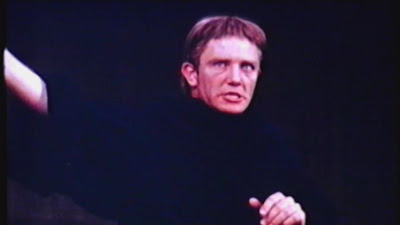In honor of a film that's finally appearing on DVD this Tuesday, I decided to go over--here--a few versions of Shakespeare's
Hamlet that have been captured in various media over the years. Every year I teach
Hamlet as part of first-year course in composition and literature, and I show as many versions as I can, trying to cover most of the important parts of the play, also showing several different versions of key scenes--the play-within-a-play, the final duel and deaths--to show that actors and directors have to make all sorts of decisions at almost every line of the play to present it. How drunk is Claudius? How much of a buffoon Polonius? Should the fourth soliloquy ("How all occasions do inform against me") even be performed? Since
Hamlet is a play, it should be watched as well as read.
Directors first have to decide what text should be used, how much of it, and in what order
. Most modern texts of
Hamlet are conflations of the three versions published during and soon after Shakespeare's life. The First Quarto (these name come from the size that the paper that formed the book was folded in) is often called the "Bad Quarto," because it's much shorter and rougher than the other two versions. Scholars once thought it was constructed from the memories of two actors who played minor roles in the play, but more recently some have argued that this is Shakespeare's "rough draft" for the play. The Second Quarto is the longest version; it contains all four soliloquies, as well as a famous passage about the tragic flaw. The Folio version was published after Shakespeare died in 1623 as part of his collected works. It's shorter than the Second Quarto (no fourth soliloquy) but includes some lines not in either version. Some critics thus claim it is Shakespeare's final version of the play, "streamlined" for performance in the theater.
Because the conflated
Hamlet runs about four hours.
So: do you cut, what do you cut, why do you cut, and what do you do with perceived imbalances in the play? How do you set the play? One set, many sets? What time period? What sort of costumes? How do you cast it? What genders? (in Kenneth Branagh's
A Midwinter's Tale, an "old queen," as he calls himself, plays Gertrude, and I've seen a Marcella, and heard about Bernhardt's Hamlet.) How Oedipal do you make the scene in Gerturde's bedchamber? Does Gertrude know the cup is poisoned? How do you handle the switching of the swords? Is the Ghost visible? Does Hamlet hear Polonius and Claudius when he asks her, "Where's your father?" Do you stage both the plays-within-the-plays, and if you do, how do you show that Claudius doesn't "get" the dumb show? And so on.

Laurence Olivier had proven he could sell audiences on Shakespeare in general with his Henry V, and when he did Hamlet a few years later, won Oscars for both Best Picture and Best Actor, but I think his achievement as a director was even greater. I have never particularly liked his characterization: too pretty, too epicene, too weak (maybe it's that blond wig the Brits think a Dane should have). However, his physicality in the duel scene is amazing: the leap he takes on to Claudius is one he used to do every night in the theater. It does have one of my favorite Horatios, Norman Wooland (seen above next to Larry), and as strong a cast of actors in minor roles as any version: John Lawrie and Anthony Quayle in the still, Stanley Holloway as the Gravedigger, and Peter Cushing as Osric (or the Grand Moff Tarkin as I tell students today). But why is Osric usually always portrayed in British performaces as such a homosexual fop?
As far as directing, just watch the way Olivier presents The Mousetrap (he only shows the dumb show). The stage is set with the audience forming a "U" with Claudius, Gertrude, and Polonius at the bottom of the U, the play at the top, Horatio at the top of the right side of the U, and Hamlet and Ophelia at the top left. The camera starts behind Horatio, then tracks down the U, behind the royal couple, who are kissing and thus missing what's happening, and then up to behind Hamlet, with Hamlet staring at Horatio, Horatio staring at Claudius, and the action visible on the stage. The camera then retracks, and this time you can see from behind that Claudius is watching the play (Polonius is very concerned), and back, till Olivier cuts to a close-up of Claudius shielding his eyes. It's masterful, with an economy of cuts, and every camera movement meaningful, purposeful. It's a shame that Olivier didn't get to direct more Shakespeare on film than the three he did.
Costumes: seventeenth-century. Black-and-white. Cuts: extensive, and the second and third soliloquies are juggled so that they are not as close as they are in the play.







